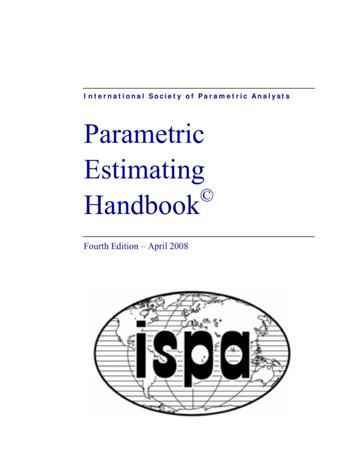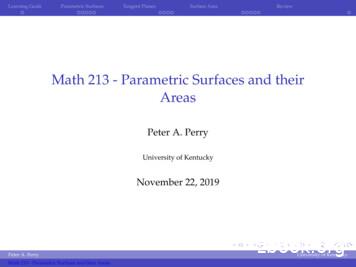Parametric Estimating Handbook, 4th Edition
International Society of Parametric AnalystsParametricEstimating HandbookFourth Edition – April 2008
International Society of Parametric AnalystsParametric Estimating Handbook, Fourth EditionCopyright 2008 (Unlimited Rights Granted to the US Government)ISBN # 0-9720204-7-0.ISPA/SCEA Joint Office527 Maple Avenue East, Suite 301Vienna, VA 22180703-938-5090Fax 703-938-5091www.ispa-cost.org
Table of ContentsList of FiguresPrefaceIntroductionPart OneThe Basics of Parametric AnalysisCHAPTER 1PARAMETRIC ANALYSIS OVERVIEW1.11.21.3Best Practices of the Parametric Analysis Process . 1-11.1.1 The Parametric Model Building Process . 1-31.1.2 Parametric Model Use. 1-13Cost Estimating Relationships . 1-161.2.1 Data Characteristics and Sources. 1-161.2.2 Data Normalization. 1-201.2.3 CER Development . 1-211.2.4 CER Validation. 1-23Complex Models. 1-241.3.1 Comparison of Complex Models and CERs. 1-241.3.2 Complex Tools in the Estimating Process . 1-251.3.3 Development of Complex Tools. 1-261.3.4 How Good Is the Estimate? . 1-33Part TwoThe Application of Parametric AnalysisCHAPTER 2DATA COLLECTION AND ANALYSIS2.12.22.32.4Data Types and Collection. 2-1Data Sources . 2-2Routine Data Normalization Adjustments . 2-52.3.1 Inflation. 2-62.3.2 Non-Recurring and Recurring Costs. 2-62.3.3 Cost Improvement Curve. 2-72.3.4 Production Rate. 2-7Significant Data Normalization Adjustments . 2-82.4.1 Adjustment for Consistent Scope. 2-82.4.2 Adjustment for Anomalies. 2-8International Society of Parametric Analystsi
TABLEOFCONTENTS2.52.62.4.3 Data Adjustment Analysis Example . 2-9Government Evaluation Issues . 2-10Other Considerations . 2-112.6.1 Resources . 2-112.6.2 Information in the Wrong Format. 2-112.6.3 Differences in Definitions of Categories . 2-122.6.4 The Influence of Temporal Factors. 2-122.6.5 Comparability Problems . 2-122.6.6 Database Requirements. 2-12CHAPTER 33.13.23.33.43.53.63.73.8iiCOST ESTIMATING RELATIONSHIPSCER Development . 3-23.1.1 Cost CERs. 3-23.1.2 Overall CER Development Process . 3-33.1.3 Development Database . 3-43.1.4 Testing the Logic of a CER . 3-5CER Development Examples . 3-53.2.1 Developing Simple CERs . 3-63.2.2 Lessons Learned from CER Implementation. 3-12Curve Fitting and OLS Regression Analysis . 3-123.3.1 Graphical Method . 3-133.3.2 OLS Regression Analysis . 3-133.3.3 Assumptions, Limitations, and Caveats of OLS. 3-153.3.4 Multiple Regression . 3-173.3.5 Curvilinear Regression and Cost Improvement Curve Analysis3-18Testing the Significance of the CER. 3-19When to Use a CER . 3-233.5.1 Strengths . 3-233.5.2 Weaknesses . 3-23Examples of CERs in Use. 3-243.6.1 Construction. 3-243.6.2 Electronics. 3-243.6.3 Weapons Procurement . 3-24CERs from the Defense Procurement and Acquisition Policy . 3-253.7.1 Cost Estimating Relationship Definition . 3-253.7.2 Steps for Developing a Cost Estimating Relationship. 3-253.7.3 Identifying Situations for Use. 3-263.7.4 Developing and Using Estimating Factors . 3-273.7.5 Developing and Using Estimating Equations . 3-273.7.6 Identifying Issues and Concerns . 3-28Evaluating CERs. 3-293.8.1 Government Evaluation Criteria . 3-293.8.2 Logical Data Relationships . 3-293.8.3 Credible Data . 3-31International Society of Parametric Analysts
PARAMETRIC ESTIMATING HANDBOOK3.8.4 Strength of CER Relationships . 3-313.8.5 CER Validation. 3-313.8.6 Summary of CER Evaluation. 3-32CHAPTER 44.14.24.34.44.54.6Background . 4-24.1.1 General Definitions . 4-24.1.2 Examples of Proprietary Models . 4-3The Model Development Process . 4-44.2.1 Step 1: Identifying the Parametric Opportunity . 4-64.2.2 Step 2: Preliminary Model Design . 4-64.2.3 Step 3: Information Systems Needs . 4-64.2.4 Step 4: Data Collection and Analysis . 4-74.2.5 Step 5: Model Development . 4-84.2.6 Step 6: Calibration and Validation . 4-104.2.7 Step 7: Estimating System Policies and Procedures . 4-114.2.8 Step 8: Internal Approval Process . 4-124.2.9 Step 9: External Approval Process . 4-124.2.10 Step 10: Model Maintenance . 4-13Evaluation Criteria . 4-154.3.1 Cost Benefit Analysis . 4-164.3.2 Information System Controls . 4-16Summary Example: Jet Engine Cost Model . 4-17Lessons Learned . 4-17Best Practices . 4-18CHAPTER 55.15.25.35.45.55.65.7COMPANY DEVELOPED COMPLEX MODELSCOMPLEX HARDWARE MODELSBackground . 5-1Overview of Hardware Cost Modeling . 5-2The Parametric Cost Modeling Process . 5-65.3.1 Define Objectives . 5-65.3.2 Data Collection and Analysis . 5-75.3.3 Model Calibration . 5-75.3.4 Model Validation . 5-105.3.5 Forward Estimating . 5-11Commercially Available Hardware Models . 5-12Lessons Learned from the Use of Complex Hardware Models . 5-12Best Practices . 5-14Conclusions . 5-14International Society of Parametric Analystsiii
TABLEOFCONTENTSCHAPTER 66.16.26.36.46.56.66.76.8Background . 6-16.1.1 Software and Programming Languages . 6-46.1.2 Software Development Methodologies. 6-46.1.3 Software Support . 6-86.1.4 Software Capability Maturity Model Integration (CMMI)Models. 6-96.1.5 Manager’s Checklist for Validating Software Cost andSchedule Estimates . 6-136.1.6 Software Estimating Techniques . 6-13Overview of Software Parametric COST Models . 6-156.2.1 Function Point Models. 6-156.2.2 Conversion of Function Points to SLOC . 6-186.2.3 Object Points. 6-196.2.4 Use Case Points (UCPs). 6-196.2.5 Normalized Use Cases (NUCs) . 6-20Cost Model Selection. 6-206.3.1 Step 1: Determine User Needs. 6-206.3.2 Step 2: Select Candidate Models . 6-216.3.3 Step 3: Choose the Most Appropriate Model or Models . 6-216.3.4 Step 4: Reevaluate the Choice . 6-22Intelligent Use of Software Models . 6-226.4.1 Input Data. 6-236.4.2 Model Validation . 6-236.4.3 COCOMO II . 6-246.4.4 Example: REVIC – Revised COCOMO Model . 6-246.4.5 Example: Software Experience. 6-25Future Directions of Software Estimating . 6-266.5.1 New Development and Support Concepts . 6-266.5.2 Reuse and COTS Integration . 6-266.5.3 New Cost Models. 6-26Lessons Learned. 6-27Best Practices . 6-28Conclusions. 6-29CHAPTER 77.1ivCOMPLEX SOFTWARE MODELSGOVERNMENT COMPLIANCERegulatory Compliance . 7-17.1.1 The Truth in Negotiations Act (TINA) . 7-27.1.2 FAR, DFARS, and Estimating Systems . 7-37.1.3 Cost Accounting Standards (CAS) . 7-57.1.4 Federal Acquisition Regulations and Sundry Issues . 7-77.1.5 Subcontracts . 7-87.1.6 Earned Value Management System (EVMS) andContractor Cost Data Reports (CCDR) . 7-10International Society of Parametric Analysts
PARAMETRIC ESTIMATING HANDBOOK7.27.37.1.7 Best Practices . 7-10Parametrics and the Government Review Process . 7-117.2.1 General Estimating System Requirements . 7-127.2.2 Parametric Estimating System Requirements . 7-137.2.3 Parametric-Based Proposals . 7-197.2.4 Best Practices . 7-21Technical Evaluation of Parametrics . 7-227.3.1 Authority to Evaluate Parametric Techniques . 7-227.3.2 Cost Modeling Process for CERs . 7-237.3.3 Projecting Beyond the Historical Range . 7-277.3.4 Breaks in Production . 7-297.3.5 Personnel Reassignments and Relearning . 7-297.3.6 Best Practices . 7-30CHAPTER 88.18.28.38.48.5Tailor Applications to Customer Needs. 8-1Considerations When Applying Tools. 8-2When and How to Use the Various Tools and Techniques . 8-3General Applications . 8-38.4.1 Forward Pricing Rate Models . 8-48.4.2 Subcontractor Price or Cost Analysis Using Vendor Data . 8-68.4.3 Cost As an Independent Variable (CAIV) . 8-98.4.4 Risk Analysis . 8-118.4.5 Bid/No Bid Analysis . 8-138.4.6 Conceptual Estimating . 8-138.4.7 Independent Cost estimates (ICEs). 8-148.4.8 Design to Cost (DTC) . 8-158.4.9 Life Cycle Cost Estimates. 8-158.4.10 Budget Planning Analysis. 8-178.4.11 Proposal Evaluation, Red Team Reviews. 8-178.4.12 Should Cost Studies . 8-178.4.13 Estimate at Completion (EACs). 8-188.4.14 Costing by Phase of Contract. 8-188.4.15 Trade Studies . 8-188.4.16 Sensitivity Analysis . 8-198.4.17 Basis of Estimates (BOE’s) . 8-198.4.18 Affordability and Cost Realism . 8-208.4.19 Cost Spreading . 8-22Summary . 8-23CHAPTER 99.1OTHER PARAMETRIC APPLICATIONSINTERNATIONAL USE OF PARAMETRICSFrance. 9-19.1.1 General Applications . 9-19.1.2 Examples. 9-19.1.3 Regulatory Considerations. 9-2International Society of Parametric Analystsv
TABLEOFCONTENTS9.29.3Germany. 9-59.2.1 General Applications . 9-59.2.2 Examples. 9-59.2.3 Regulatory Considerations. 9-5United Kingdom. 9-89.3.1 General Applications . 9-89.3.2 Examples. 9-89.3.3 Regulatory Considerations. 9-8Appendix AModel Builders - Commercial Software DescriptionsAppendix BDetailed Math of Cost Estimating RelationshipsAppendix CFrequently Asked QuestionsAppendix DRelated Web Sites and Supplementary InformationAppendix EParametric Estimating ChecklistsAppendix FMemorandum of Understanding for Parametric ModelsAppendix GParametric Cost Estimating Initiative Closure ReportAppendix HSpace Systems Cost Analysis Group Risk SummaryAppendix ISpace System Cost Analysis Group, Nonrecurring andRecurring Cost Definitions and Cost Accounting GuidelinesAppendix JEstablishing a Parametric Implementation TeamAppendix KPreparation of Subsystem Level DatasheetsGlossaryReferencesHandbook User CommentsviInternational Society of Parametric Analysts
PARAMETRIC ESTIMATING HANDBOOKList of FiguresFigure 1.1Figure 1.2Figure 1.3Figure 1.4Figure 1.5Figure 1.6Flowchart of Cost Model Development by the Practitioner. 1-3More Hypothetical Plot Points .
Handbook Fourth Edition – April 2008 . International Society of Parametric Analysts . 6.1.5 Manager’s Checklist for Validating Software Cost and . Handbook User Comments vi International Society of Parametric Analysts . PARAMETRIC ESTIMATING HANDBOOK
Surface is partitioned into parametric patches: Watt Figure 6.25 Same ideas as parametric splines! Parametric Patches Each patch is defined by blending control points Same ideas as parametric curves! FvDFH Figure 11.44 Parametric Patches Point Q(u,v) on the patch is the tensor product of parametric curves defined by the control points
parametric models of the system in terms of their input- output transformational properties. Furthermore, the non-parametric model may suggest specific modifications in the structure of the respective parametric model. This combined utility of parametric and non-parametric modeling methods is presented in the companion paper (part II).
Electrical Construction Estimating Introduction to Electrical Construction Estimating Estimating activites will use the North State Electric estimating procedures. Estimating and the Estimator Estimating is the science and the art by which a person or organization determines in advance of t
Learning Goals Parametric Surfaces Tangent Planes Surface Area Review Parametric Curves and Parametric Surfaces Parametric Curve A parametric curve in R3 is given by r(t) x(t)i y(t)j z(t)k where a t b There is one parameter, because a curve is a one-dimensional object There are three component functions, because the curve lives in three .
that the parametric methods are superior to the semi-parametric approaches. In particular, the likelihood and Two-Step estimators are preferred as they are found to be more robust and consistent for practical application. Keywords Extreme rainfall·Extreme value index·Semi-parametric and parametric estimators·Generalized Pareto Distribution
parametric and non-parametric EWS suggest that monetary expansions, which may reflect rapid increases in credit growth, are expected to increase crisis incidence. Finally, government instability plays is significant in the parametric EWS, but does not play an important role not in the non-parametric EWS.
use a non-parametric method such as kernel smoothing in order to suggest a parametric form for each component in the model. Here, we explore issues that arise in the use of kernel smoothing and semi-parametric approaches in estimating separable point process models for wildfire incidence in a particular region.
validated awards is a matter of prime importance to the OU. The OU will take any action it considers necessary under its Royal Charter to protect the quality of validated programmes of study and the standard of its validated awards. A1.6 Quality assurance As a UK University, the OU is subject to the requirements and expectations of UK higher education, as represented by the Quality Assurance .























